The Hatinh langur (Trachypithecus hatinhensis) is a primate native to the forests of Vietnam, particularly in Quang Binh and Quang Tri provinces[1,2]. Despite its name, it is not found in Ha Tinh province. It is also called stripe-headed black langurs. The local Van Kieu minority refer to this langur as the ‘Con Cung’, which translates as “black, cliff-dwelling monkey with a long tail” [3].
Other names: Stripe-headed black langurs, Voọc Hà Tĩnh/Voọc đen Hà Tĩnh/Voọc gáy trắng (Vietnam), con cung (Bru/Van Kieu people)
The Hatinh langur is classified as Endangered (EN) on the IUCN Red List. This means the species faces a very high risk of extinction in the wild, primarily due to habitat loss and hunting pressures in its limited range in central Vietnam.
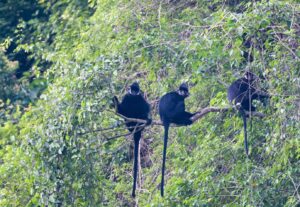
APPEARANCE
This species closely resembles the François’ langur (Trachypithecus francoisi) but can be distinguished by a unique band of white fur that extends from the cheeks behind the ears down onto the nape. The Hatinh langur’s coat is predominantly lustrous black with a slight brownish tinge, covering the entire body and tail. It also features a characteristic hair crest on top of the head.
Infants are born with bright yellow fur, making them stand out among the group. This striking coloration is believed to support a behavior known as alloparenting, in which other members of the group help care for the young. The infant’s fur darkens after about two months and eventually turns completely black [4].
Hatinh langurs have five-digit hands and feet, making them highly dexterous. The head-to-body length ranges from 54–57 cm in females and 56–59 cm in males. Their average weight is around 6–8 kg, and the tail length ranges from 78–90 cm. Both sexes are covered in black pelage; however, females have light-colored hairs in the pubic area, which remains the primary visual cue for sex identification [5,6].
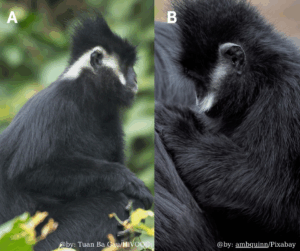
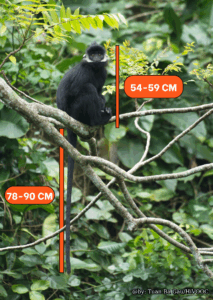
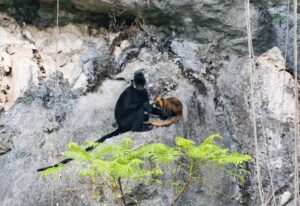
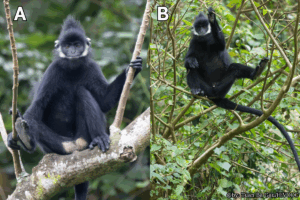
GEOGRAPHIC DISTRIBUTION AND HABITAT
Hatinh langurs inhabit dense Annamite mountain range limestone forests with the upper elevation limit of 1,500 m. Hatinh langurs are endemic to central Vietnam; they can be found inhabiting limestone karst forests. Their presence is documented in Tuyen Hoa, Minh Hoa, Thach Hoa, Bo Trach, Le Thuy, and Quang Ninh districts in Quang Binh Province; Bac Huong Hoa Nature Reserve in Quang Tri Province [1,2]. Hatinh langurs were also spotted in Mot and Con Rong mountains of karst areas in Cam Lo district, Quang Tri [3].
No exact population numbers were determined. The largest population is believed to reside in Quang Binh, Phong Nha-Ke Bang with the varied population estimates from as low as 150 to a high of 2,143 individuals in 2013 [1,2].
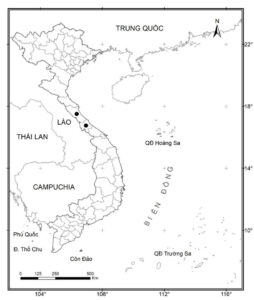
DIET
Hatinh langurs are folivores, in other words, leaf consumers; they primarily feed on leaves, along with fruits and flowers. In general, their diet includes 81% leaves, 9% fruit, 9% vines, and 1% flowers [1].
LIFESTYLE
Hatinh langurs are diurnal and primarily arboreal, spending most of their time in trees. This animal tends to establish sleeping sites in small limestone caves and holes.
They are gregarious animals, typically forming groups of 2 to 15 individuals, although larger groups of up to 30 have been observed. Typically, a group will comprise one adult male, multiple females, and offspring [7].
Regarding communication, Hatinh langurs communicate through vocalizations along with other forms of communication, such as body posturing and facial expressions. When in danger, the adult males use alarm calls to warn the groups. This species also gets involved in allogrooming, or the grooming of each other, to solidify bonding with members in a group [4].
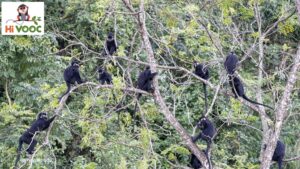
REPRODUCTION AND FAMILY
Reproduction season occurs from January to June. The gestation period is about 200 days, females typically give birth to a single infant. Females become mature after 4 years while males take 4-5 years to reach maturity. The lifespan is 20-25 years [2].
ECOLOGICAL ROLE
Hatinh langurs contribute to the ecosystem by being important seed dispersers by spreading undigested seeds from the fruits, thereby facilitating plant growth.
CONSERVATION STATUS AND EFFORTS
The International Union for Conservation of Nature (IUCN) classifies the Hatinh langur as Endangered, primarily due to habitat loss from deforestation, road construction, illegal logging, and hunting pressures. This species is also listed in Appendix I of CITES and recognized as a critically endangered and protected species under Decree No. 64/2019/ND-CP and Decree No. 84/2021/ND-CP issued by the Government of Vietnam.
Some conservation successes have been achieved. For example, strict gun legislation controls and weapon confiscation significantly reduce langur shootings. The Endangered Primate Rescue Center in Cuc Phuong National Park, Vietnam, also made a successful breeding program [1,2]. However, more efforts are needed to implement awareness-raising education, effective wildlife law and policy, etc.
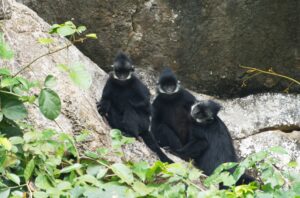
HiVOOC’S INITIATIVE FOR THE CONSERVATION OF HATINH LANGURS
HiVOOC has officially launched the meaningful initiative “WIDLIFE TOURISM FOR CONSERVATION (WTFC)” in collaboration with the Hatinh Langur conservation community in the buffer zone of Tuyen Hoa, Quang Binh. Here, every tourist is expected to plant at least one tree. We believe this initiative will help preserve the habitat of the endangered Hatinh langurs and encourage environmentally responsible and sustainable ecotourism. Tourists contribute to generating income for local people and motivating the community to join hands in protecting the langur.
Every tour to the protected areas of Hatinh langurs made by HiVOOC is always accompanied by enthusiastic members of the conservation community. When coming here, tourists are introduced to how such a community is operated and how the conservation efforts are brought into reality. Members of the community are responsible for conducting pre-site surveys and locating langurs’ spots so that tourists could have the best experiences of the tour.
On every tour like this, a part of the tour’s expenses is given to the community’s members to aid in their earnings. Also, HiVOOC commits to the sponsor of the Hatinh conservation community from 20 to 50 USD per tour, depending on the number of tourists and the experiencing duration.
In addition, HiVOOC supports partial financial support, technical training, and equipment procurement for the conservation community to patrol the protected areas of the Hatinh langur’s populations.
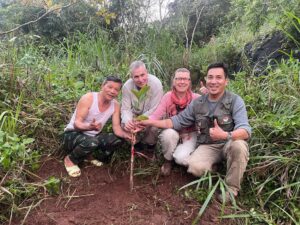
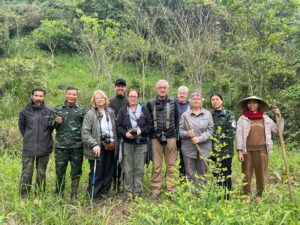
Join HiVOOC and Hatinh langur’s conservation community in the journey of recovering and developing sustainably the populations of this endemic langur species.
Contact Information:
Email: Info@hivoo.com
Phone number: (+84) 914 000 940
REFERENCES
1. Quyet, L.K., Coudrat, C.N.Z., Phiaphalath, P., Nadler, T. & Covert, H. 2021. Trachypithecus hatinhensis (amended version of 2020 assessment). The IUCN Red List of Threatened Species 2021: e.T40789A196139355. https://dx.doi.org/10.2305/IUCN.UK.2021-1.RLTS.T40789A196139355.en. Accessed on 26 April 2025.
2. Nguyễn Đình Duy, Trịnh Đình Hoàng, Nguyễn Vĩnh Thanh, Hà Thăng Long, 2023. Trachypithecus hatinhensis. Danh lục Đỏ Việt Nam. MM19
3. Hatinh Langur. Wikipedia.
4. Táo, H. (2023, December 18). Phát hiện đàn voọc Hà Tĩnh quý hiếm ở núi đá vôi phía đông Quảng Trị. Tuổi Trẻ Online. https://tuoitre.vn/phat-hien-dan-vooc-ha-tinh-quy-hiem-o-nui-da-voi-phia-dong-quang-tri-2023121814060282.htm
5. Nadler, T. (2010). Color variation in Hatinh langurs (Trachypithecus [laotum] hatinhensis). Vietnamese Journal of Primatology, 4, 13-18.
6. New England Primate Conservancy. (n.d.). Hatinh Langur, Trachypithecus hatinhensis. Retrieved April 26, 2025, from https://neprimateconservancy.org/hatinh-langur/
7. Endangered Primate Rescue Center. (n.d.). Hatinh Langur – Trachypithecus hatinhensis. Retrieved April 26, 2025, from https://www.eprc.asia/hatinh-langur/

